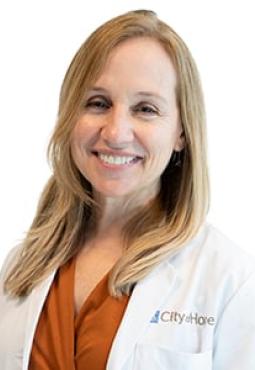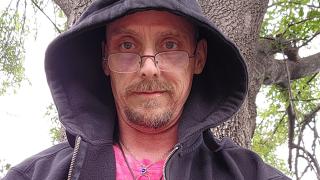“I can honestly say,” declared Michael Evrard, a City of Hope patient, “that I just had the greatest Easter ever.”
It’s a little hard to square those words with the fact that barely 90 days earlier, Evrard was wheeled into an operating room for emergency brain surgery.
Evrard, a self-described “musician, artist and philosopher” thinks deep thoughts, expressing them through his photography, guitar and books (three so far: “Why Are We Here On Earth?”, “How Life Works” and “All That Exists”), and strives to stay connected to everything and everyone around him. He and his wife Tammy practice qigong, an ancient Chinese movement regimen intended to optimize energy within the body, mind and spirit.
Adopted as an infant together with his twin brother Patrick, he remembers an essentially healthy childhood, though he admits to some addiction issues in his youth. Now 53, he was celebrating his birthday on Jan. 20, 2023, when everything suddenly changed.
“I was hit with four seizures,” he recalled.
The seizures and accompanying hallucinations sent the family rushing to the emergency room. Tests revealed a brain tumor and, three days later, surgeons removed it. The pathology report came back grim: Evrard had a glioblastoma, the most common and highly aggressive form of brain cancer, which strikes some 13,000 Americans every year. Most do not live very long.
“The prognosis in general,” said neuro-oncologist Jana Portnow, M.D., co-director of City of Hope’s Brain Tumor Program, “is less than two years.”
Out of the Blue
The news stunned Tammy.
“We always live in the ‘now,’” she said. “We’re grateful for what we have, whether it’s one day or many years. But this was a big surprise. It just shakes you. And I needed to know: Was there something we had missed?”
No one knows what causes glioblastoma. Though it is more commonly found in people ages 45 to 70, it can affect anyone at any age. A tiny minority of cases may have a genetic component, but the vast majority are not hereditary. As far as the adopted Evrard could determine, there was no brain cancer in his birth family.
Surgery does not cure glioblastoma. Nothing else does either. Treatment focuses on removing the tumor, then following up with radiation, chemotherapy and other means to keep the cancer at bay for as long as possible.
Evrard needed to find a treatment plan and a reliable place to receive it, quickly — a daunting research project. Normally he could easily handle such a task. Both he and Tammy work as service coordinators for disabled people, helping them get the resources they need. They know how to work the phones and get results.
But surgery had left Evrard, in Tammy’s words, “out for the count,” with neither the stamina nor executive functioning ability to begin searching. The task fell to her, and she knew where to look first.
“Michael couldn’t make decisions,” she recalled. “But I knew his family had experience with City of Hope.
“So, I called.”
'Total Dedication and Caring'
What she heard at the other end of the line convinced her.
“I’m going over the details and the person on the phone interrupts and says, ‘Oh, how is he?’ And then she asks me, ‘And how are you?’ I was totally thrown by that — such total dedication and caring from people you don’t expect.”
That call set the tone for what would ultimately be a life-affirming experience for her and Evrard.

“I can’t say enough good things about them. The whole experience was great,” Evrard said. He frequently punctuates Tammy’s narrative with philosophical insights like, “Allow the seeds of hope to grow into a tree of faith." This is very much their modus operandi: Evrard waxes poetic, and Tammy, totally supportive (“My role,” she says, “is to help Michael explore who he is”) while keeping her husband on point.
They bonded immediately with Portnow, whom Evrard calls “amazing.” Portnow put him on a two-part plan: several weeks of radiation supplemented by chemotherapy pills designed to enhance the radiation’s effect, followed by higher doses of chemo given five days a month for up to six more months.
Evrard also received a new, non-invasive treatment known as TTF, or tumor treating fields. It uses an electrode-laden cap, worn on the head, to send electrical impulses into the brain, disrupting the tumor’s ability to grow. Portnow enrolled Evrard in a Phase 3 study to help determine when (before or after radiation) is the ideal time for deploying the device.
It’s hard to call anyone with brain cancer “lucky.” But Portnow points out that Evrard has some positive factors going for him.
“He had an excellent resection,” she explained. “He’s otherwise healthy. And his tumor has MGMT promoter methylation, which means it doesn’t do a good job of repairing the DNA damage inflicted by chemotherapy. Its repair mechanism is silenced,” making the chemo more effective.
Reaching Out for Support
The Evrards have another powerful weapon at their disposal: Nicole Peeke, LCSW, ACHP-SW, a City of Hope clinical social worker who offered counseling and support.
“Couples going through brain cancer diagnosis and treatment together have better outcomes,” said Peeke, a 12-year City of Hope veteran. “When patients and partners have each other, they can tackle cancer as a strong team instead of alone.”
The key, says Peeke, is communication: making sure each partner relates honestly with the other.
“They often have the same fears but, in wanting to protect one other, don't express them,” she said. “My role is to help them have an honest dialogue and be a mutual source of support. For couples, it is a relief to address topics that many of them are thinking about but haven’t been able to express. After the session, I see the couple physically moving closer, touching, hugging and connecting. It’s very personally rewarding to be with the couple in their journey, to partner in their care and to alleviate the fear of being alone."
The process begins with a questionnaire that “helps us identify their stressors and gauge their understanding of their condition. It helps me get them both on the same page,” Peeke added.
Peeke meets with couples facing a cancer diagnosis with a goal of “validating what’s right in the relationship” and offering tools and techniques to help them “be mindful and intentional toward each other, to show up for each other.”
Peeke partners with the Division of Neurology and colleagues across the Department of Supportive Care Medicine to offer patient navigators, spiritual care and group sessions with multiple couples “so they don’t feel isolated.”
“I’ve received such positive feedback from the couples that having a forum to dialogue about how cancer is impacting them as a couple is very helpful. We acknowledge what is lost — but focus on what is left.”
Because of the couple's spiritual bent, Peeke connected them with the Rev. Fr. Okey Jude Oche, M.A., Ph.D., B.C.C., chaplain in the Division of Spiritual Care Services at City of Hope, who provides faith-based guidance and support and, like the Evrards, is passionate about the connection between mind, body and spirit for optimal health.
The Bigger Picture
“We recognize that cancer care also involves loved ones and the community, beyond the person with the diagnosis,” said Andrew T. Leitner, M.D., associate professor in the Division of Interventional Pain Management and the newly appointed chair of the Department of Supportive Care Medicine.
For the Evrards, it was the way Peeke extended herself that made all the difference.
“Nicole stayed with us throughout our meetings with Dr. Portnow,” marveled Tammy, “always asking us what we needed.”
“It’s the way I do things,” said Peeke, adding that working with the Evrards is easy because of the harmony the couple already displays. “They don’t really need that much support. They’re already on the same page.” Peeke also helped the Evrards’ 19-year-old daughter enroll in a support group for children of brain cancer patients.
Even with all of that support, the Evrards understand that they face long odds. But they are at peace with where they are, and Evrard, in his signature “we’re all connected” worldview, takes in the big picture and admits much of it is unknowable, but nevertheless expresses faith and sees reason for hope.
“They gave me two years, and I was OK with that,” he says. “They believe in me. Like all of us, my future is a mystery. But I know I will graduate from this.”
The Department of Supportive Care Medicine at City of Hope was the first in the United States to fully integrate across supportive care specialties and into the patient’s clinical care and is one of the largest programs of its kind today. The program provides cancer patients with comprehensive physical, psychological, social and practical support services, including care navigation; survivorship programs; specialists in cancer and aging; child life specialists; psychological and spiritual counseling; pain management; integrative medicine, such as yoga, massage and meditation; and more — all with a focus on maximizing patient and family strengths, quality of life and the ability to best engage in their treatment journey and beyond. Thanks to a gift from The Sheri and Les Biller Family Foundation, City of Hope is working to expand this offering across its cancer care system and to advocate for establishing supportive care as a standard best practice for cancer care in the United States.
